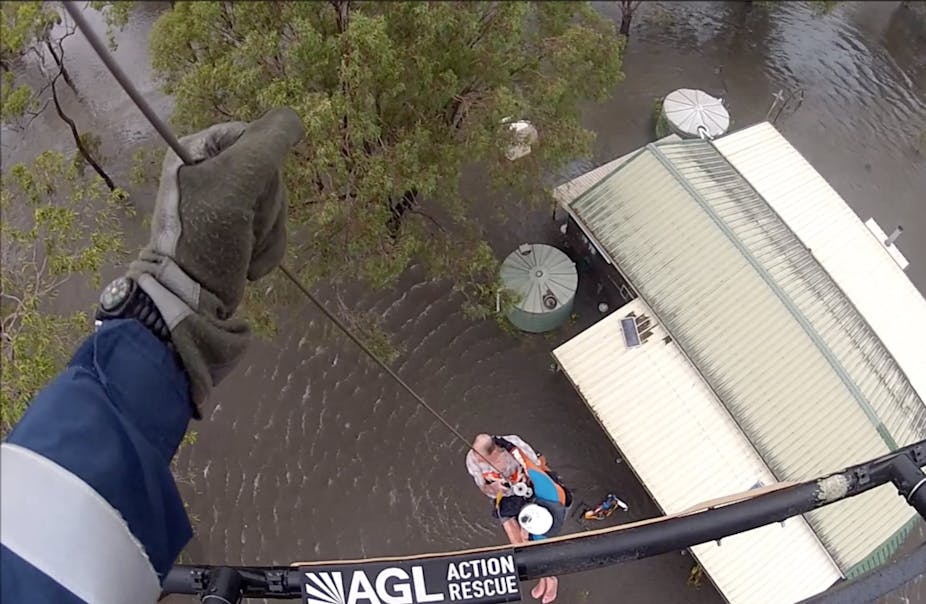The floods in Queensland and Northern New South Wales and the extensive January bushfires which caused destruction across Tasmania, Victoria and New South Wales confirm that we need to rethink how we plan for, and respond to, natural disasters.
Many believed the 2010-11 floods and cyclones in Queensland were an aberration. The term, a “one in 100 year event” provides people (including those responsible for disaster management) with a false sense of security.
How can a one in 100 year event occur twice in two years?
Changing the terminology to a “100 to one chance” of occurring every year does not clarify the risk for the person whose house or business is flooded so soon after they have rebuilt. It also ignores the fact that serious weather events are occurring more frequently, with greater severity each time.
Communicating risk
According to the United Nations Centre for Research on the Epidemiology of Disasters, the frequency of climate related disasters such as tropical cyclones, typhoons and hurricanes has increased tenfold since records began in 1950. Climate change will continue to make weather patterns less predictable and more extreme. We need to reframe our language.
In recent times there have been major improvements in the quality of warnings from the Bureau of Meteorology and SMS based systems such as Emergency Alert. But in every event, there are those who ignore the advice. Risk communication and the information given by political leaders and experts needs to change to reduce the complacency, and in some cases cynicism, in the community.
We must find a way to make people take seriously the calls to evacuate before it becomes too dangerous to do so. The images of citizens in North Bundaberg being plucked from their rooftops by helicopters, only hours after authorities had told residents to leave, or of vehicles trapped in flood waters despite the much repeated public message of “if it’s flooded, forget it”, should cause all of us to rethink this messaging.
This anti-social behaviour not only puts emergency services heroes, many of whom are volunteers, at great personal risk but also diverts resources from other critical response activities. Public messages about the dangers are just not getting through. Perhaps it is time for a community debate about stronger deterrents such as legal sanctions.
Planning for the new normal
In terms of disaster planning and preparation, the traditional orthodoxy is no longer enough.
This century we have seen hurricanes Sandy and Katrina devastate North America, earthquakes and tsunamis wreak havoc in Japan, Aceh, Sumatra, Samoa and Christchurch, and the Gulf of Mexico choked by a massive oil spill. At home, we have been battered by fires and floods, followed by more fires and more floods. These experiences have shown that our planning assumptions have been too narrow.
We must be capable of responding to unpredicted or unpredictable events. Relationships are critical to successful planning, response and recovery. They need to be developed during “peace time” so that roles and responsibilities of all agencies are clear when disaster strikes. Training must not only focus on particular skills but also on the roles and relationships of those involved in the development of an agile, flexible, scalable, and sustainable disaster management system.
The serious gap in disaster management policy in Australia is the need for integrated policy and funding focused on building resilience.
According to US National Academy of Sciences:
Resilience is the ability to prepare and plan for, absorb, recover from and more successfully adapt to adverse events. Enhanced resilience allows better anticipation of disasters and better planning to reduce disaster losses — rather than waiting for an event to occur and paying for it afterwards.
This requires a much greater injection of resources into both mitigation and adaptation to reduce the personal, economic and environmental costs of natural disasters.
Mitigation and adaptation
Greater investment in infrastructure, such as levees, sea walls, dams; and construction initiatives such as fire resistant materials, raised housing and earthquake tolerant foundations can reduce the impact of disasters.
Community awareness and information can be enhanced through initiatives to improve weather and hazard forecasting, hazard mapping, warning systems and evacuation procedures.
Regulatory reforms such as the requirement for local, district, state and national disaster plans, land use planning and zoning requirements and disclosure requirements such as flood or fire vulnerability at point of land, house or business sales are also a part mitigation and adaptation initiatives, many of which are relatively low cost.
Community expectations of what the government must do for them in the wake of natural disasters are increasing. That is how it should be.
But building resilience requires a shared responsibility between individuals, local communities and governments. Improving how we talk to people and broadening our planning assumptions are good places to start.

